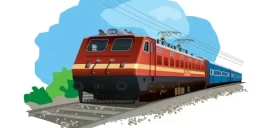YARD
A yard may be defined on the basis of the functions it performs. It is a place or the activity centres on the Railway system, where the trains or rolling stocks are received, reformed into trains or loads after marshalling and are dispatched to their destination. Necessity of Yard
1. Formation of trains/loads by shunting of wagons as per their destinations.
2. To conduct intensive examination of trains/wagons.
3. For shunting of sick wagons in order to detach them from train for repairing.
4. To change engine or crew.
5. Acceptance of train without detention to them.
6. Minimizing average detention of wagons.
7. Forming Bulk load for farthest destination.
8. Maximize productivity of resources.
9. Ensuring safety. Determination of place for construction of yard
1. Places where trains from various directions arrives.
2. Where big industrial hubs are developed.
3. Where coal and mineral mines are located.
4. At big terminal station.
5. Big transshipment station. Classification of yards are classified into different types on the basis of following factors
1. On the basis of geographical location.
2. On the basis of the functions it performs.
On the basis of geographical locations
On the basis of geographical location yards can be classified into three types
Flat Yards
Flat yards are generally laid in the flat or level land where shunting operations are carried out by push and pull methods with the help of engines. These yards are constructed where lesser shunting operations are performed. Such yards are economically efficient but slow in working and wasteful in shunting engine hours.
Hump Yards-
Hump yards are constructed by providing gradient between reception and the sorting and despatch lines and the grids. The gradients are erected by construction of an artificial hump suitable for the purpose. The gradient of the hump is created in such a manner that the roll down on their own to specified sorting line. The load is pushed up by the engine towards the hump from one side of the hump so that the uncoupled portion of the load rolls away towards another side of the hump in sorting/dispatching line. There yards are economical to flat yards. So these yards are constructed where more shunting is performed.
Gravity Yards-
Gravity yards are constructed where the natural contour of the land permits a suitable falling gradient stretched over a sufficient length. The falling gradient makes it possible to use the yards to the fullest extent in marshalling wagons/trains thus minimizing the use of engine power. Therefore gravity yards are more economical than flat yards but the layout of it dependent on the availability of plenty of land with the required topography which is seldom possible.
Depending Upon Works-
Depending upon works yards can be classified as
1. Terminal Yards
2. Marshaling Yards
3. Transit Yards
Terminal Yards– The station where train lines terminals is called Terminal station. The yards attached to terminal station are called Terminal yards, where large numbers of wagons are loaded and/or unloaded. Traffic either originates on terminates at these yards. e.g. JNPT yard.
Marshalling Yards– In these yards marshalling of trains are performed. Wagons are arranged in a particular manner and new trains are formed. Trains are broken up on different sorting lines for various directions on specified destinations, as per marshalling order so as to from them into trains and prepare them for connect marshalling lines. Mughalsarai yards in the biggest marshaling yards in Asia.
Transit Yards- The yards which receive and despatch trains without any shunting on them are classified as Transit Yards. In such yards generally Crew, Engine on C&W examination etc. only take place in addition to formation of a few loads. Sectional trains are formed in these yards. These yards are constructed in between two marshaling yards. Through trains are not admitted at these yards so as to minimize detention of trains.











